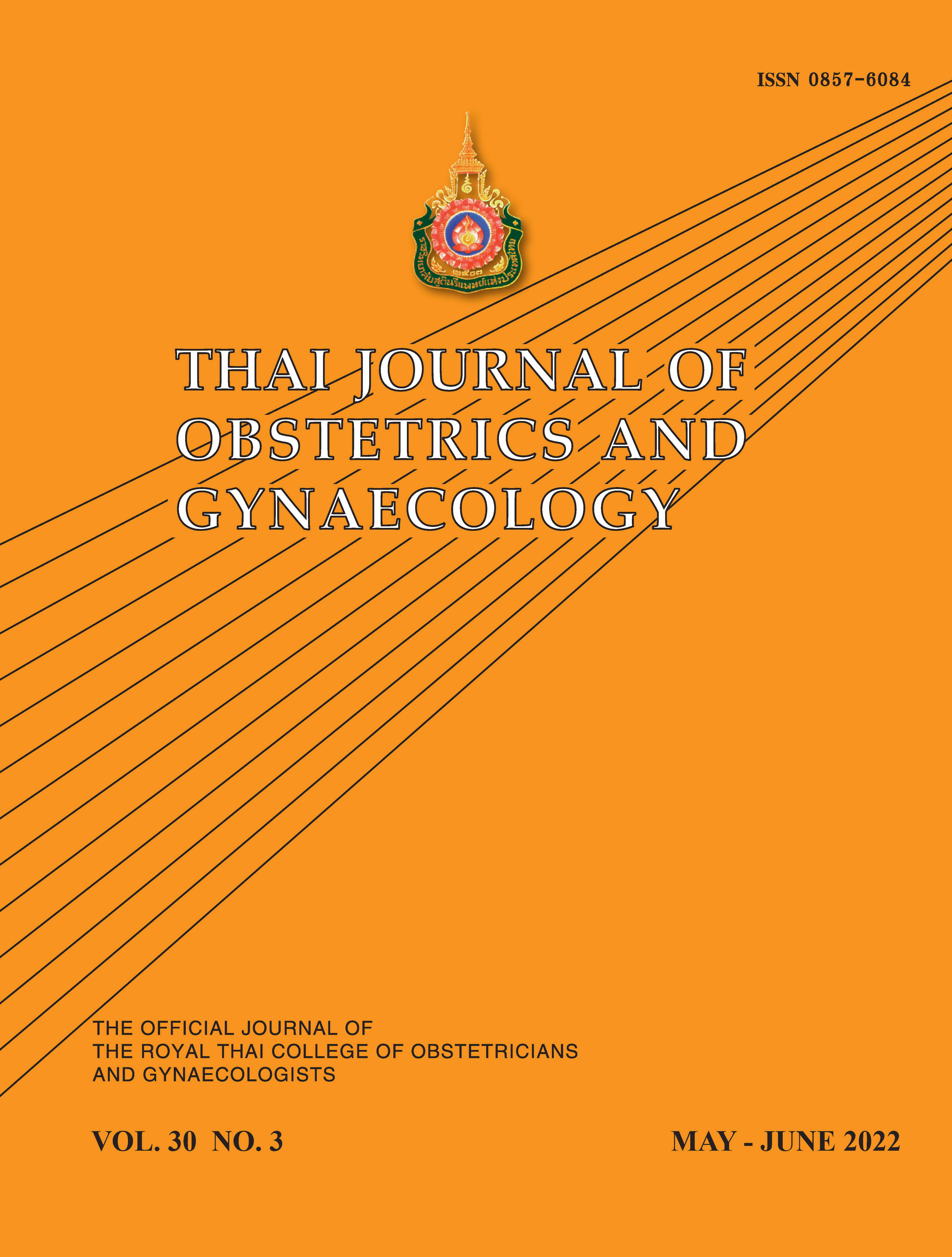Cold Pack Compression to the Lower Abdomen after Childbirth to Reduce Blood Loss in Women Undergoing Vaginal Delivery: A randomized controlled trial
Main Article Content
Abstract
Objectives: To determine the efficacy of cold pack compression to the lower abdomen after childbirth until 2 hours postpartum to reduce blood loss.
Materials and Methods: Sixty singleton pregnant women who underwent normal delivery at Khon Kaen Hospital between February and June 2020 were randomly allocated to two groups, one receiving cold pack compression to the lower abdomen after childbirth until 2 hours postpartum (n = 30) versus standard vaginal delivery (n = 30). The respective amount of blood loss in both groups was measured from after childbirth until 2 hours postpartum by calculating the total weight of blood from the blood collecting bag and diapers. Additional blood transfusion, adverse events from the cold pack, and the after-pain score were recorded.
Results: Baseline characteristics between groups were comparable. Mean blood loss in the cold pack compression group was significantly lower than the standard vaginal delivery group (183.87 ± 76.52 vs. 271.36 ± 103.80 ml, mean difference was -87.50, 95% confidence interval -134.62 to -40.37, p < 0.001). None of the participants in either group experienced postpartum hemorrhage or required blood transfusion. None of the participants in the cold pack compression group experienced any adverse events. There was no statistical difference in the after-pain score between groups.
Conclusion: Cold pack compression to the lower abdomen after childbirth until 2 hours postpartum could significantly reduce blood loss compared with standard vaginal delivery without serious adverse events.
Article Details

This work is licensed under a Creative Commons Attribution-NonCommercial-NoDerivatives 4.0 International License.
References
Trends in maternal mortality: 2000 to 2017: estimates by WHO, UNICEF, UNFPA, World Bank Group, and the United Nations Population Division. Geneva: World Health Organization 2019.
Say L, Chou D, Gemmill A, Tunçalp Ö, Moller AB, Daniels JD, et al. Global causes of maternal death: a WHO systematic analysis. Lancet Glob Health 2014;2:e323-33.
Cunningham FG, Leveno KJ, Bloom S, Spong CY, Dashe JS, Hoffman BL, et al. Williams obstetrics. 25th ed. New York: McGraw-Hill Medical 2018:755-802.
Weeks A. The prevention and treatment of postpartum haemorrhage: what do we know, and where do we go to next? BJOG 2015;122:202-10.
World Health Organization. WHO recommendations for the prevention and treatment of postpartum haemorrhage. 2012:4-7.
Mitchell JL, Stecher J, Crowson J, Rich D. Uterine cooling during cesarean delivery to reduce blood loss and incidence of postpartum hemorrhage: a randomized controlled trial. Obstet Gynecol 2015;125:9s-10s.
Nawasirodom N, Sangkomkamhang U, Sangkomkamhang T. Uterine cooling during cesarean section to reduce intraoperative blood loss: a randomized controlled trial. Thai J Obstet Gynaecol 2019;27:47-53.
Masuzawa Y, Kataoka Y, Nakamura S, Yaju Y. Cooling the lower abdomen to reduce postpartum blood loss: A randomized controlled trial. PLoS One 2017;12:e0186365.
Kataoka Y, Nakayama K, Yaju Y, Eto H. Comparison of policies for the management of care for women and newborns during the third stage of labour among Japanese hospitals, clinics and midwifery birth centers. Int J Childbirth 2015;5:200-9.
Waite NG. Blood components. In: Rhoades RA, Bell DR, editors. Medical physiology: principles for clinical medicine. 4th ed. Philadelphia: Lippincott Williams &Wilkins 2013:166-87.
Wray S, Jones K, Kupittayanant S, LI Y, Matthew A, Monir-Bishty E, et al. Calcium signaling and uterine contractility. J Soc Gynecol Investig 2003;10:252-64.
Wray S, Kupittayanant S, Shmigol T. Role of the sacroplasmic reticulum in uterine smooth muscle. Novartis Found Symp 2002;246:6-18.
Sunano S. The effects of Ca antagonists, manganese and lanthanum on cooling-induced contracture of depolarized vas deferens. Jpn J Pharmacol 1984;34: 51-6.
Galloway KM. Cryotherapy and moist heat. In: Jeffrey DP, David AB, eds. Orthopaedic physical therapy secrets. 3rd ed. St. Louis, Missouri: Elsevier Inc;2017:54-9.


